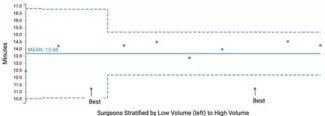Why It Matters
"Positive deviance — an approach that identifies and learns from those who demonstrate exceptional performance — offers us a head start for ideas on how to solve the problem we are trying to address."

Photo by Eric Prouzet | Unsplash
With new challenges facing health care on what can seem like a daily basis, it is tempting to assume that we always need new ways to deal with them. I was fortunate to moderate a session at the most recent IHI Scientific Symposium that reminded me of how we sometimes neglect some of the most powerful improvement tools we already have at our disposal. For example, positive deviance — an approach that identifies and learns from those who demonstrate exceptional performance — offers us a head start for ideas on how to solve the problem we are trying to address.
For the initiative he described on improving operating room capacity, Daniel Low, MD, a pediatric anesthesiologist and Associate Professor of Anesthesiology at the University of Washington (UW) in Seattle, brought together several innovative approaches that improved efficiency, with resulting major financial benefit to the organization. Low is also Chief Medical Officer at AdaptX, a start-up that uses an algorithm to convert vast quantities of everyday electronic health record data into funnel plots and run charts that give clinicians and managers a real-time look into their processes and outcomes.
But data is only the start. The team at UW’s funnel plot (Figure 1 below) indicated that there were positive outliers in the process they were tracking — the time it took to prepare the patient for surgery once they arrived in the Operating Room (OR prep time). When OR capacity is limited (as it is in so much of the world because of COVID-19), minutes count towards how many procedures can be done in a day. The funnel plot showed that 2 of the 9 surgeons had prep times that were very much (>3 sigma) shorter than their colleagues.

What happened next illustrates the coming together of the very best ideas for system change. I identified six key steps they took that led to their results:
- Conducted deep enquiry into the processes used by the two “positive deviants” using stratification and systems thinking
- Created new standard work for OR prep time assembled from synthesis of the best ideas
- Tested the new standard work, including time tracking and display of OR prep time variation and progress
- Established a leadership role by having the lead surgeon do the first test of the new standard work
- Other team members adopted and adapted new standard work
- Celebrated success — The team determined that the new standard approach resulted in an increase of 25 percent of OR case volume using the same resources. This translated to more than $2.5 million in additional revenue.
![Steps in the Positive Deviance Approach [from: Bradley EH, Curry LA, Ramanadhan S, et al. Research in action: Using positive deviance to improve quality of health care] Steps in the Positive Deviance Approach [from: Bradley EH, Curry LA, Ramanadhan S, et al. Research in action: Using positive deviance to improve quality of health care]](/sites/default/files/styles/max_325x325/public/resources/insights/Graphic_Steps-in-Positive-Deviance-Approach.jpg.webp?itok=yNAnU8_8)
I also observed that the UW team loosely followed a 4-step process for including positive deviance in rapid improvement efforts. In addition, they used key psychology of change principles that maximized the role of leadership to drive rapid change.
The team from UW combined a new and easier way to get data insights with a tried-and-true method to learn from outliers. By doing so, they have addressed some of the financial impact of COVID-19 by helping to make surgical care more efficient.
Pierre Barker, MD, is Chief Scientific Officer at IHI.
You may also be interested in:
What Kind of Quality Department Best Supports Whole System Quality?
